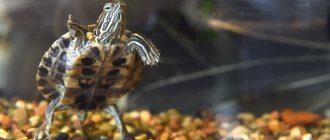Review author: “ZooVita”
Turtles are interesting animals. They have been very popular in Europe for many years, and for good reason. They do not create problems when it comes to care, but breeding these reptiles requires the owner not only to acquire knowledge, but also to be willing to deepen it.
Content
“I want to have a turtle at home,” parents often hear from their children. This reptile is an ideal pet for a child, recommended by doctors, because, theoretically, it does not cause allergies.
On the other hand, they are demanding and rather fragile animals. A common mistake in keeping pet turtles is to simply keep them on the floor. They need to be provided with proper temperature, humidity, soil, and safety.
First you need to decide whether the turtle will be an aquatic pet or a typically land turtle. Each group requires different conditions. If it is water-land, a suitable aquaterrarium with the required amount of water is created.
Crumbs in the shell: the life period of little turtles
Not everyone is ready to have a large reptile at home. Much more often, babies up to 13 cm in size act as original pets. Despite their miniature size, such “cuties” live quite a long time.
Lifespan of a tiny turtle:
- three-keel - from 20 to 25 years;
- musky - 23;
- spotted - from 30 to 40;
- silt - from 50 to 60;
- Reeves (pond) - 58.
Requirements for aquatic reptiles
Often, pet stores sell coin-sized babies and convince the buyer that a 30-liter aquarium will be the ideal solution. This is mistake. Even for a small reptile, the aquarium must be spacious, but for an adult, it must be taken into account that a minimum of 200-300 liters of water will be required.
Effective filtration is required, preferably in the form of an external filter, appropriate lighting, including UV, and a proper diet. Aquaterrariums use soil and gravel.
Causes of premature death
The most common causes of death of pets are:
- Improper conditions of detention. Small aquarium, dirty unfiltered water, untimely cleaning, inappropriate temperature conditions.
- Infections. They can appear from aquarium plants, decorative elements, and live food.
- Poor nutrition and lack of vitamins. In nature, a turtle can compensate for the deficiency of any element on its own; when kept at home, monitoring the diet is the owner’s task.
- Lack of qualified veterinary specialists who can correctly and timely diagnose health problems and prescribe adequate treatment.
Keeping land turtles
For a land turtle, it is necessary to prepare a terrarium measuring at least 120 cm by 50 cm. The correct temperature must also be guaranteed.
In one part - 30-35 degrees Celsius with low humidity, and in the other - 25-28 degrees with humidity up to 70%. Then the reptile will be able to bask on the “island of heat” created using a heating lamp, or find a cooler place.
You need to choose the right substrate. For most terrestrial species, a homemade mixture of soil, sand and a small amount of clay works well. An alternative is turf, which is a dug-out piece of lawn containing soil.
Decorative elements and hiding places will decorate the terrarium and will be useful. Amphibians need several places to hide and feel safe. You can put pots, coconut shells, twigs with leaves. The presence of sufficient light is necessary for the normal development of the shell.
300 years - myth or truth? About the lifespan of turtles
For these reptiles the rule is: the more, the longer. How many years turtles live in the wild depends primarily on their size. Their lifespan can be 30 - 50 years (small), 80 years (medium) to 120 - 150 years (giant individuals).
How many years sea turtles live is determined by their size. They are usually large - from 70 to 140 cm. They live in warm seas and oceans. On average, they live up to 80 years in freedom. But most do not reach such a venerable age. Many die at the embryonic stage, while in the egg (due to unfavorable temperatures). Others are eaten by predators when the babies try to get to the water.
How many years do land turtles live? Depending on the size - from 50 to 100 years. Among them there are tiny ones - about 10 cm, but there are also large specimens. The latter, naturally, have a greater chance of surviving to “retirement” age.
Aquatic species are represented by medium-sized individuals. Their size does not exceed 30 cm. They take root well in captivity. They live for about 50 years, both in aquaterrariums and in the natural environment.
All of these reptiles have a slow metabolism, which explains their longevity. The most tenacious of them are large turtles. How many years do they live? From 100 to 120 years. Perhaps many of them could live to an older age, but in their natural habitat many dangers and diseases await them, so only a few of them die a natural death. There are record holders who lived 175 and even 188 years.
The maximum age of the largest reptiles is 200 years. There is evidence that some representatives of the giant tortoises living on the Galapagos Islands are over 300 years old.
Wood turtle
Scientific name: Glyptemys insculpta. Originally from North America. It is characterized by a dark gray shell. The legs, head and abdomen are orange with black spots, the limbs are short and strong.
Males are larger than females, the size of an adult is 23 centimeters, weight is about a kilogram. They are omnivores. In spring and summer it lives on the surface, in winter and autumn it chooses an aquatic environment.
Mr. Tail Explains: Common Mistakes
All problems with these unpretentious pets arise due to the owners’ ignorance of basic maintenance rules. Most often, turtle owners make the following mistakes:
- They do not provide any terrarium for their placement. The pet is forced to look for a secluded corner in the house on its own. He collects dust under cabinets and sofas, and can get hurt and catch a cold from drafts.
- They forget to install an ultraviolet lamp in the turtle's housing. The absence of this radiation spectrum can cause many diseases in your pet.
- Scales are forcibly removed from the skin and scutes from the shells during molting. This is absolutely forbidden to do so as not to injure your pet. When washing, use only a soft cloth.
- They keep several aggressive males together. This can lead to injury and even death to the turtles.
- Wash terrariums using homemade disinfectants. This can easily poison your pets. To clean their territory, you must have your own equipment and special means.
Reptile nutrition
What to feed pet turtles. Some aquatic species are typical predators, others have a certain percentage of plants in their diet, and others are vegetarians. You need to find out this before buying a pet. They eat live, dried, prepared and frozen food.
Before lunch, frozen food must be thawed and rinsed.
Live food:
- water larvae,
- mosquito larvae,
- tadpoles and frogs,
- daphnia,
- freshwater fish,
- aquarium fish (guppies, gladioli),
- water snails,
- bloodworm,
- water beetles.
However, you should not overdo it with the amount of animal food you eat. Although it should dominate the amphibian’s diet, we must not forget about plant foods:
- pansies,
- daisies,
- dandelion leaves,
- plantain leaves,
- aquarium plants,
- clover,
- water fern,
- raspberries,
- strawberry,
- watermelon,
- grape,
- apples,
- peaches
- apricots,
- tomatoes,
- Chinese cabbage.
Usually they give as much food as the animal can eat in 5 minutes. Adults should be fed 2-3 times a week, young (up to 6 months of age) - 1 time a day, newborns (up to 3-4 months of age) - 2 times a day.
How to determine age
Find out how many years a turtle lives by looking at its shell. The length increases by 2 cm with each passing year. A turtle is born with a 3-centimeter shell. Measure the length of the shell, subtract 3, divide the resulting number by 2. So, the age of a reptile with a shell 5 cm long is 1 year, 15 cm - 6 years.
Land
Each plate dividing the carapace contains annual rings. During the first 2 years of life, 6 annual rings are formed in land species. After this, 1-2 rings are added every year. Count the rings on one plate of the shell, subtract 6, divide by 1.5 and add 2. After counting 20 rings, you can find out that the animal is 11 years old.
One
In the inhabitants of the waters, 1 annual ring is added annually. Count the number of rings on the plate and subtract the first 2 years of life. In older individuals, the pattern is unclear and blurry.
Hibernation and reproduction
The statement that turtles must hibernate every year is not always true. At home, this is not even advisable. Only a specialist can prepare an animal for hibernation and ensure the correctness of such rest, otherwise it will sleep forever.
If your pet stays in a corner of the terrarium for a long time and tries to burrow into the ground, it is probably getting ready for sleep. To prevent this from happening, it is necessary to fatten it and carefully read specialized literature on ensuring turtle hibernation so that the animal remains alive and healthy. With good care and proper nutrition, pets can live 15-30 years.
If you are serious about running a “turtle” business, it is better to start with 3 individuals of the same age and size - 2 females and 1 male. More than two men compete for territory and ladies. It is better to keep aquatic reptiles separately, allowing them to be together only for mating.
When buying a pet, you need to pay attention to the behavior - this will tell you whether the individual is healthy. The shell should be without cracks, there should be no spots on the skin, the mucous membrane of the mouth should be pale pink in color, saliva should not be sticky, breathing should be calm, no discharge from the mouth or nose.
Most turtles carry salmonella, as well as other bacteria and viruses that can be dangerous (especially to children). Therefore, you need to ensure that your child washes their hands thoroughly when coming into contact with a turtle.
Aquatic turtle: lifespan in artificial conditions
Let's start with the most popular type of such reptiles: how many years do red-eared turtles live? If you provide them with proper care, they will delight you with their presence for 25 to 30 years (the same applies to yellow-eared ones). Depending on the size of the aquarium, they can grow to the size of a large saucer (maximum - up to 30 cm). They look peculiar and can make sounds resembling a squeal or hiss.
The average lifespan of aquatic turtles living in a human home is:
- silt loggerhead - 23 years;
- Trionix Chinese Far Eastern - from 25 to 30;
- Caspian - 25;
- European marsh - 25.
On a note! Aquatic turtles require an aquarium with a pond and an island where they can rest! They definitely need access to air. And change the water promptly!
Photos of pet turtles
Main types
The species united by the common name “waterfowl turtle” are divided into:
- closing;
- flat;
- spotted;
- Chinese.
Closing
The species of secluded aquatic turtles is represented by the following subspecies:
- mud red-cheeked;
- mud walleye;
- musky keel;
- common musk.
The natural habitat of aquatic turtles of this species is the coasts of South and North America. All animals have a spherical carapace - a rib-shaped spine of the neck plate, which in case of danger the reptile tightly closes, thereby gaining complete protection.
Interestingly, the subspecies of mud turtles has developed dense membranes between the toes on the front and hind legs. Animals in nature rarely grow more than 15 centimeters in length, and the bulk of the diet consists of food of animal origin.
Flat
The species of flathead aquatic turtles has several subspecies of Homopus:
- boulengeri;
- areolatus;
- signatus;
- femoralis;
- solus.
Animals of this species are distinguished by a strongly elongated skull, and in adulthood they rarely exceed 10 centimeters in length. The head is proportional, there are special small protective shields on the neck, the carapace is convex, oval in shape, slightly extended forward. The shades of carapace range from dark brown to olive. Females are larger than males and lay up to 5 eggs in one clutch.
Spotted
A species of true amphibians, spotted water turtles are characterized by a unique ability to thrive only in tandem conditions of land and water in the conditions of their urban home. The aquarium of such an animal must be equipped with an island of land, on which the turtle will happily rest and also bask under the rays of a special heating lamp. The length of the reptile rarely exceeds 13 centimeters.
Chinese three-keel
Chinese turtles are most often found among new breeders. These wonderful animals are considered the easiest to keep and undemanding in terms of diet diversity. A water house with a volume of about 100 liters is suitable for this reptile, because the size of an adult individual of this species is only 12 centimeters.
Official record holders
Since such a long life of turtles has long intrigued humanity, examples of long-livers of these intelligent and sedate animals have been recorded. The oldest examples include:
- Marion, who lived on the territory of the Jerusalem monastery. At the time of death, the turtle was 152 years old.
- Jonathan, who lives in the courtyard of the residence of the current governor of St. Helena. Today the pet is 183 years old.
- Harietta, resident of the Australia Zoo. She died of heart disease at the age of 177.
- Kiki, a native of the Paris Zoo. 170 years old. He died in 2009 from an intestinal infection.
- Timothy, who lived in the English county of Devon. Death was recorded in 2006. He was 160 years old.
Interestingly, the record holders include the Galapagos and Seychelles reptiles, which have gigantic size and weight.
Record holders for longevity
In nature, this type of reptile really leads among living creatures in terms of life expectancy. At the same time, they are not affected by living conditions at all. When studying their physiological characteristics, scientists discovered an amazing fact. It turns out that these reptiles practically do not age. The body of an individual that has just hatched from an egg and one that is already 200 years old functions in the same way. And what a deceptive appearance - wrinkled skin, inhibited movements and delayed perception.
The large turtle, which lives in the oceans and occasionally comes onto land to breed, lives indefinitely. Scientists have not yet figured out how many years of life nature measured out for them. All of them died only from complex viral diseases; not a single individual who died a natural death has yet been found. These animals can stop the heart and fall into a state of suspended animation, and then easily come out of it again. Currently, geneticists are studying the genome of these reptiles in order to discover which gene triggers the longevity program.
It is also true that many pet turtles live for hundreds of years and can be inherited by their descendants. However, they die early due to human fault under the wheels of a car, in the teeth of a predator, due to improper care or as a result of disease.
Taking care of your health
Compliance with all the rules for the care and maintenance of waterfowl turtles in a home apartment will protect the animal from possible infections and diseases. However, any pet can get sick. Common diseases and treatments are presented in the following table:
| Disease | Symptoms | Treatment |
| Abscess / Otitis | Tumor in the ears, on the limbs | Operation |
| Pneumonia | Does not drown, falls over, does not eat, wheezes, white mucus and bubbles appear from the nose | Deadly. Treated in a hospital or at home with injections |
| Conjunctivitis/swelling/redness of the eyes | Swollen eyes, redness, suppuration under the eyelids, lack of appetite | Local treatment |
| Soft/Twisted Shell (rickets / osteopenia / hypocalcification) | Softening of the shell, its curvature | The curvature process is irreversible; local treatment |
| Helminthiasis | Diarrhea/constipation, presence of helminths in tests | Treatment by a veterinarian |
| Dermatitis/skin fungus | Increased shedding, skin redness, white growths | Treatment by a veterinarian |
Feeding
Omnivores that feed on a wide variety of foods. Variety is important to keep your turtle healthy.
You can feed: artificial food, food for aquarium fish, vegetables, aquarium plants, insects, fish, invertebrates.
In addition to variety, it is important to provide a balanced diet high in calcium. Like all wild animals that live indoors, there is a tendency to overeat.
Young turtles are mostly omnivores. But as they grow and mature, they become more and more herbivorous.
Omnivorousness means that the diet contains a large amount of protein, but in adult turtles it is much less.
Turtles of any age will prefer live prey or carrion, but should only be fed occasionally. It is also necessary to provide additional calcium for the normal formation and growth of the turtle's shell.
What to feed?
They eat almost everything, but the main food may well be artificial food for aquatic turtles, since there are many options and types. Their composition is specially selected to provide all the necessary substances for turtles. The high protein content of commercial feeds allows them to be fed in small portions.
To make feeding more balanced, add calcium and plant foods and your turtle will be quite happy.
Please note that commercial feeds most often already contain calcium additives; read the labels on the packaging.
Red-eared turtles require water to swallow because they do not produce saliva.
They can take food on land, but will drag it into the water to eat it. You can use this to your advantage and feed them in a separate container, so the water in the aquarium will remain clean for a longer time.
Feeding with plant foods
Fresh vegetables should always be given to your turtle, regardless of whether he shows interest in them or not. A good mix of vegetables contains essential fiber, calcium, vitamins A and K.
Aquarium plants can also be given, especially since they are similar to those that the turtle has in nature.
It is especially important to feed adult and old turtles with plant foods! Their diet should consist of 75% vegetables and aquarium plants.
It can be duckweed, riccia, ludwigia, hornwort, lettuce, pieces of cucumber and zucchini, boiled dandelion and nettle, clumps of filamentous algae.
Live food (guppies, snails)
Omnivores, they happily eat everything they can get their hands on. The turtle's victims will include insects, snails, small fish and worms, crickets, etc.
So the question of whether guppies and red-eared turtles can get along in the same aquarium is not at all worth it. The same can be said about any aquarium fish, even large ones can bite.
Despite the attractiveness and availability of such foods, they should be given in moderation.
It is better to feed special food for turtles, since they are balanced and do not tolerate diseases and parasites.
How much and how often should I feed?
A difficult question, since for the most part it depends on the size, age and the food you give.
Turtles up to one year old need to be fed artificial food daily, and you can also give plant food daily, even if she refuses. But a turtle older than a year can be fed every other day or even two. However, plant foods can again be fed more often.
The amount of food may also vary. Newly hatched turtles should receive more protein, approximately 50% of the total food.
Since most turtle foods contain about 40%, you can additionally feed fish such as guppies, insects, and earthworms.
For adult turtles, the percentage of artificial food is reduced to 10-25%, and the rest should be various plants.
Since the size, shape and composition of feed can vary significantly, you need to focus on what the manufacturer writes on the packaging.











